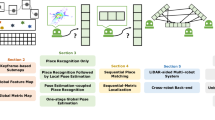Abstract
Autonomous Mobile Robots (AMR) need a positioning function to move into unknown areas. These kinds of vehicles do not use a magnetic tape to guide into warehouses. Therefore, AMR use two different alternative techniques to solve the localization problem. First one is based on absolute positioning, and second one is established on relative localization. The absolute localization uses Simultaneous Localization and Mapping algorithms, in order to obtain a global position. However, the relative localization is based on odometry techniques. With the intention of developing a navigation system for an industrial mobile robot, which is being programmed in a structured text language, a relative localization is done utilizing LiDAR data acquisition. This novel concept analyzes two LiDAR datasets from different periods to calculate the AMR movement, by implementing Point matching and Linear Regression (LR) techniques. To understand the differences between conventional Iterative Closest Point (ICP) and LR a comparison is performed.
Access this chapter
Tax calculation will be finalised at checkout
Purchases are for personal use only
Similar content being viewed by others
References
Cawood, G.J.; Gorlach, I.A.: Navigation and locomotion of a low-cost Automated Guided Cart, pp. 83–88. IEEE, November 2015
Cho, B., Seo, W., Moon, W., Baek, K.: Positioning of a mobile robot based on odometry and a new ultrasonic LPS. Int. J. Control Autom. Syst. 11, 333–345 (2013). https://doi.org/10.1007/s12555-012-0045-x
Montemerlo, M., Thrun, S.: Simultaneous localization and mapping with unknown data association using FastSLAM, vol. 2, pp. 1985–1991. IEEE (2003)
Zhang, F., Li, S., Yuan, S., Sun, E., Zhao, L.: Algorithms analysis of mobile robot SLAM based on Kalman and particle filter, pp. 1050–1055. IEEE, July 2017
Wang, X., Li, W.: Design of an accurate yet low-cost distributed module for vehicular relative positioning: hardware prototype design and algorithms. TVT 68, 4494–4501 (2019). https://doi.org/10.1109/TVT.2019.2901743
Borenstein, J., Everett, H.R., Feng, L., Wehe, D.: Mobile robot positioning: sensors and techniques. J. Robot. Syst. 14, 231–249 (1997). https://doi.org/10.1002/(SICI)1097-4563(199704)14:43.3.CO;2-1
Chambers, A., Scherer, S., Yoder, L., Jain, S., Nuske, S., Singh, S.: Robust multi-sensor fusion for micro aerial vehicle navigation in GPS-degraded/denied environments. In: American Automatic Control Council, pp. 1892–1899, June 2014
Zheng, F., Tang, H., Liu, Y.: Odometry-vision-based ground vehicle motion estimation with SE(2)-constrained SE(3) poses. IEEE Trans. Cybern. 49, 2652–2663 (2019). https://doi.org/10.1109/TCYB.2018.2831900
Chiella, A.C.B., Machado, H.N., Teixeira, B.O.S., Pereira, G.A.S.: GNSS/LiDAR-based navigation of an aerial robot in sparse forests. Sensors 19, 4061 (2019). https://doi.org/10.3390/s19194061. https://search.proquest.com/docview/2296660065
Cui, J., Wang, F., Dong, X., Yao, K.A.Z., Chen, B.M., Lee, T.H.: Landmark extraction and state estimation for UAV operation in forest. In: TCCT, CAA, pp. 5210–5215, July 2013
Gressin, A., Mallet, C., Demantke, J., David, N.: Towards 3D lidar point cloud registration improvement using optimal neighborhood knowledge. ISPRS J. Photogramm. Remote Sens. 79, 240–251 (2013). https://doi.org/10.1016/j.isprsjprs.2013.02.019
Yang, B., Chen, C.: Automatic registration of UAV-borne sequent images and LiDAR data. ISPRS J. Photogramm. Remote Sens. 101, 262–274 (2015). https://doi.org/10.1016/j.isprsjprs.2014.12.025
Du, S., Zheng, N., Ying, S., Liu, J.: Affine iterative closest point algorithm for point set registration. Pattern Recogn. Lett. 31, 791–799 (2010). https://doi.org/10.1016/j.patrec.2010.01.020
Oomori, S., Nishida, T., Kurogi, S.: Point cloud matching using singular value decomposition. Artif. Life Robot. 21(2), 149–154 (2016). https://doi.org/10.1007/s10015-016-0265-x
Papadopoulo, T., Lourakis, M.I.A.: Estimating the Jacobian of the singular value decomposition: theory and applications. In: Computer Vision - ECCV 2000, pp. 554–570. Springer, Heidelberg (2000)
de Freitas, S.M.S.F., Scholz, J.P.: A comparison of methods for identifying the Jacobian for uncontrolled manifold variance analysis. J. Biomech. 43, 775–777 (2010). https://doi.org/10.1016/j.jbiomech.2009.10.033
Chang, C., Chang, C., Tang, Z., Chen, S.: High-efficiency automatic recharging mechanism for cleaning robot using multi-sensor. Sensors (Basel, Switzerland) 18, 3911 (2018). https://doi.org/10.3390/s18113911
Acknowledgments
Mercedes–Benz Vitoria is also acknowledged in especially to Emilio, Jose Carlos Velasco, the final assembly maintenance department of Mercedes-Benz Vitoria, Javier Loredo, Javier Gómez, Jose Antonio Hernando and Tomás Hernandez to give the opportunity to makes this research in intelligent production.
Author information
Authors and Affiliations
Corresponding authors
Editor information
Editors and Affiliations
Ethics declarations
This research was financed by the plant of Mercedes-Benz Vitoria through PIF program to develop an intelligent production. Moreover, The Regional Development Agency of the Basque Country (SPRI) is gratefully acknowledged for economic support through the research project “Motor de Accionamiento para Robot Guiado Automáticamente”, KK-2019/00099, Programa ELKARTEK. The authors are grateful to the Government of the Basque Country and to the University of the Basque Country UPV/EHU through the SAIOTEK (S-PE11UN112) and EHU12/26 research programs, respectively.
Rights and permissions
Copyright information
© 2021 The Editor(s) (if applicable) and The Author(s), under exclusive license to Springer Nature Switzerland AG
About this paper
Cite this paper
Teso-Fz-Betoño, D., Zulueta, E., Sánchez-Chica, A., Fernandez-Gamiz, U., Uriarte, I., Lopez-Guede, J.M. (2021). A Relative Positioning Development for an Autonomous Mobile Robot with a Linear Regression Technique. In: Herrero, Á., Cambra, C., Urda, D., Sedano, J., Quintián, H., Corchado, E. (eds) 15th International Conference on Soft Computing Models in Industrial and Environmental Applications (SOCO 2020). SOCO 2020. Advances in Intelligent Systems and Computing, vol 1268. Springer, Cham. https://doi.org/10.1007/978-3-030-57802-2_60
Download citation
DOI: https://doi.org/10.1007/978-3-030-57802-2_60
Published:
Publisher Name: Springer, Cham
Print ISBN: 978-3-030-57801-5
Online ISBN: 978-3-030-57802-2
eBook Packages: Intelligent Technologies and RoboticsIntelligent Technologies and Robotics (R0)




